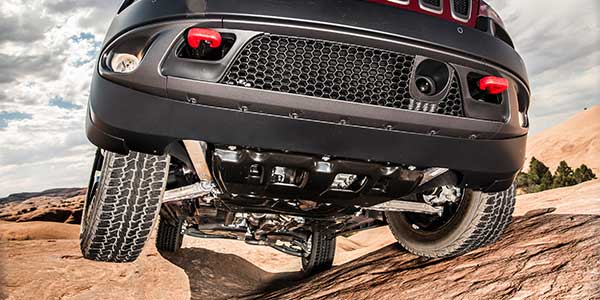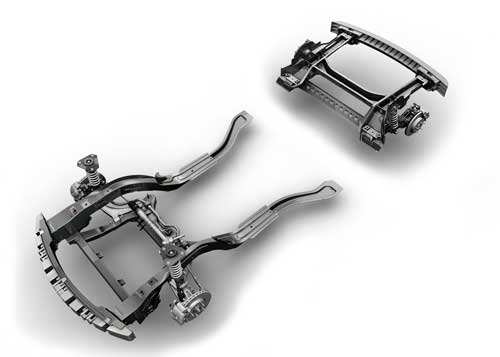
Humans and animals have had the ball and socket joints for millennia. This simple design has been used on vehicles since the turn of the century because, well, it works. But, just as our hip joints grow feeble with use and age, the ball joints, tie rods and sway bar links on a car wear out as well.
For humans, wear can be accelerated by injury, scar tissue and arthritis entering the joint. On suspension components, injured boots can cause contaminates like salt, sand and metal particles to enter the joint and cause wear.
Inspection
If you went to the doctor and he pulled out a pry bar and a large set of pliers for the examination, you might get a little scared and fear that his diagnostic effort will be more damaging than the actual problem. The same goes for ball joints and tie rods: Any OEM- or suspension manufacturer-recommended procedure for inspecting a ball joint rarely involves a pry bar, and almost never involves a set of pliers. Just like a doctor, you must use your eyes and hands.
Ball Joints
Unlike a rubber bushing, a spherical ball joint is designed to pivot through multiple planes. Of course, because the ball joint constantly pivots at different angles, it tends to wear out more rapidly than bushings. These can be found on ball joints, tie rods and some swaybar links.
Ball joints can be broken down into the load-bearing and non-load (follower) bearing types. A load-bearing ball joint supports the weight of the vehicle, while providing a hinge point for the steering system. Most load-bearing ball joints are designed to cancel the effects of normal wear by centering themselves in their sockets.
Non-load-bearing ball joints, on the other hand, maintain precise movement in a steering or suspension system.
Wear in a non-load-bearing ball joint will cause a noticeable change in the camber, caster or toe angle of a front suspension. This is why non-load-bearing joints are preloaded to compensate for wear. Unloaded control arm ball joints, for example, should be tested for preload when the suspension system is disassembled.
A ball joint is made up of a housing, ball stud, bearings, end cover and Belleville washer or spring. A Belleville washer is a conical-shaped spring designed to be loaded in the axial direction. The joint is attached to a control arm by pressing the joint into the arm or riveting the joint to the arm. If the joint is pressed into the arm, it will require a special tool to remove the old joint and install the new one.
Failed joints can be difficult to remove because of corrosion between the control arm and joint. This is especially true where a steel ball joint housing is pressed into an aluminum control arm. When the joint is riveted to the control arm, the rivets are drilled out or cut with an air chisel. The new joint is replaced using bolts and locking nuts.
Tie Rod Ends
Tie rod end ball and socket wear is different because the loads are different. Instead of supporting loads, they change the direction of the wheels. This can cause wear in the verticle plane rather than a horizontal plane. The “dry-park” testing method will indicate excessive wear in most tie rod ends.
Inner tie rod ends found on steering racks should be tested for excess wear by listening for a knocking or clicking noise as the steering is turned. Whatever the method used, remember that small amounts of wear in each tie rod end can add up to a major variation in toe angle.
Technicians often have a problem locating OE specifications for joint testing. In many cases, a vehicle manufacturer’s warranty tolerances are simply too liberal for real-world alignment situations. In other cases, a manufacturer simply leaves the issue to the technician’s judgment. This allows for the real-world effects that cumulative bushing and ball joint wear will have on the steering and suspension system as a whole.
If you use a pry bar and brute strength, your inspection could be influenced by the bushings in the control arms. If you use a set of water pump pliers to compress a tie rod, it will give you a false reading almost every time and is not a measure of wear for some types of tie rods; even some new tie rods will compress.
It may look dramatic to the customer when you take a set of pliers to compress some tie rods, but OEMs recommend technicians use their hands to pull and push on tie rods to feel for play.
Ball Joint Inspection
Some ball joints that have a grease fitting use the fitting as a wear indicator. If a grease gun will not couple to the fitting, the joint needs to be replaced. As the joint wears, the Belleville washer or spring maintains the tension on the bearings to maintain zero axial endplay as the control arms move. Lateral wear causes the ball stud to move inside the bearing. It can affect camber and tire wear. The Belleville washer or spring will not compensate for lateral wear.
Loaded Joint: To check a loaded ball joint, place a jack or jack stand under the lower control arm to support the weight of the vehicle. Attach a dial indicator to the lower control arm and locate the dial in a vertical position to measure axial run-out at the steering knuckle.
For an SLA suspension that has the coil spring over the top arm, the upper joint is loaded. To check the joint, the upper control arm is supported to unload the joint. If the ball joint has a built-in wear indicator, joint play should be checked while the vehicle is on its wheels.
Follower Joint: To check a follower-type joint, the Belleville washer or spring is loaded or compressed to check for axial end-play. For a strut-type suspension, place a jack stand under the cradle to allow the strut to fully extend. Attach the dial indicator clamp to the lower control arm and locate the dial in a vertical position to measure axial run-out at the steering knuckle. Place a jack under the ball joint and load the joint by raising the jack. Turn the steering wheel and observe the ball joint to check lateral run-out.
For an SLA suspension, the upper control arm can be blocked and the joint can be compressed. Attach a dial indicator to the steering knuckle and place in a vertical or parallel position to measure axial run-out at the lower control arm. Moving the steering knuckle can check lateral run-out.
Replacement
Nothing is worse than finishing the replacement of a suspension component and going for the test drive only to find that another component might not be up to the standards of the new part. It could be a new strut that is working with a worn out spring, or the ball joint you replaced is now connected to a control arm with bad bushings. In many cases, the repair or part does not return the vehicle to 100% operating condition.
Every year, there are new options becoming available to help a shop return a suspension to 100% operating condition. These assemblies have “loaded,” “complete” or “quick” in their name. These include struts, control arms, tie rods and even knuckles. Some parts manufacturers are looking at complete corner modules that would include every component that attaches to the frame or unibody of the vehicle. The main advantage of a loaded or complete assembly is not the cost of the part, but rather the efficiency it offers the technician and the greater effectiveness of the repair.
These components can be pricey when viewed on the parts screen, but you need to calculate the value, repair effectiveness and customer satisfaction.














